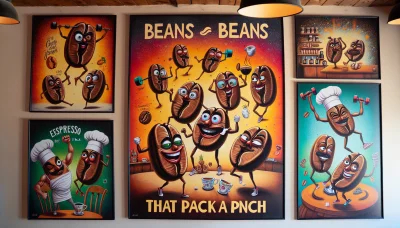Cold brew vs espresso Quiz
Test Your Knowledge
Question of
Cold Brew vs Espresso: An Introduction
Cold brew and espresso are both popular coffee beverages, but they differ significantly in taste, preparation, and caffeine content. Cold brew is made by steeping coarse coffee grounds in cold water for an extended period, usually 12 to 24 hours, resulting in a smooth, mild flavor with lower acidity. On the other hand, espresso is made by forcing a small amount of nearly boiling water through finely-ground coffee beans, producing a concentrated and bold coffee shot with a creamy top layer called crema. The brewing process of espresso is quick, taking about 25 to 30 seconds, which contrasts sharply with the slow brewing method of cold brew. These differences make each beverage unique, catering to different preferences and occasions.
What is Cold Brew?
Cold brew is a method of brewing coffee that involves steeping coarsely ground coffee beans in cold water for an extended period, typically 12 to 24 hours. Unlike traditional hot coffee brewing methods, cold brew is made without heat, resulting in a coffee concentrate that is diluted with water or milk before serving. The flavor profile of cold brew is often described as smoother and less acidic than hot brewed coffee, with a naturally sweeter taste. This method also tends to highlight the chocolate, nutty, and caramel notes of the coffee, making it a favorite among those who prefer a less bitter beverage. The reduced acidity and bitterness, along with its refreshing coolness, make cold brew a popular choice, especially during the warmer months. Additionally, its concentrated form allows coffee enthusiasts to experiment with different dilution levels and recipes, further customizing their coffee experience.
What is Espresso?
Espresso is a concentrated form of coffee served in shots and is renowned for its rich flavor and creamy consistency. The brewing process involves forcing a small amount of nearly boiling water through finely-ground coffee beans under high pressure. This method extracts the coffee's intense flavors and aromas, producing a strong and robust cup that stands as the foundation for many coffee drinks, such as lattes, cappuccinos, and Americanos. Espresso's characteristics include a complex flavor profile, a layer of creamy foam on top known as crema, and a higher concentration of dissolved solids than regular coffee, which contributes to its bold taste and body. It appeals to coffee lovers who appreciate a more concentrated and flavorful cup of coffee, as well as those who enjoy the ritual and craftsmanship involved in espresso preparation.
The Brewing Process: Cold Brew vs Espresso
-
Cold Brew:
- Coarsely grind coffee beans.
- Mix coffee grounds with cold water.
- Steep the mixture in the fridge for 12-24 hours.
- Strain the coffee concentrate to remove the grounds.
- Dilute the concentrate with water or milk before serving.
-
Espresso:
- Fine grind coffee beans.
- Tamp the grounds into the espresso machine's portafilter.
- Heat water to just below boiling.
- Force the hot water through the grounds at high pressure.
- Serve immediately.
Flavor and Caffeine Content
| Aspect | Cold Brew | Espresso |
|---|---|---|
| Flavor Notes | Smooth, chocolatey, and less acidic | Rich, robust, and more concentrated |
| Caffeine Levels | Varies, generally higher due to concentration | 63 mg per 1 oz serving |
| Recommended Consumption Times | Any time, often enjoyed cold | Morning or early afternoon |
Health Benefits and Considerations
When it comes to choosing between cold brew and espresso, both coffee preparations offer unique health aspects that are worth considering. Cold brew is often praised for its lower acidity levels, which can make it a gentler option for individuals with sensitive stomachs or those prone to acid reflux. This reduced acidity can lead to a smoother taste and may minimize the digestive discomfort sometimes associated with traditional coffee consumption. On the other hand, espresso, while higher in acidity, is concentrated and offers a robust flavor profile. It contains antioxidants and nutrients in a more concentrated form, which can be beneficial for health in moderation. However, due to its strength and higher acidity, espresso might not be suitable for everyone, especially those with certain digestive conditions. Ultimately, the choice between cold brew and espresso should be based on personal preference and any specific health considerations.
Conclusion: Which One Should You Choose?
In summary, both cold brew and espresso offer unique benefits and experiences for coffee lovers. Cold brew, known for its smooth, mild flavor and lower acidity, is an excellent choice for those who prefer a gentler coffee experience or enjoy their coffee cold. It's also a great option for making in large batches to have on hand throughout the week. On the other hand, espresso is ideal for those who appreciate a robust, concentrated coffee flavor and may enjoy the ritual of brewing a fresh cup. Its versatility serves as a base for a wide range of coffee drinks, making it suitable for those who like variety in their coffee routine. Ultimately, the choice between cold brew and espresso comes down to personal preference and lifestyle. Consider your taste preferences, how much time you want to spend on preparation, and how you like to enjoy your coffee. Experimenting with both can also be a delightful journey to finding your perfect cup.












